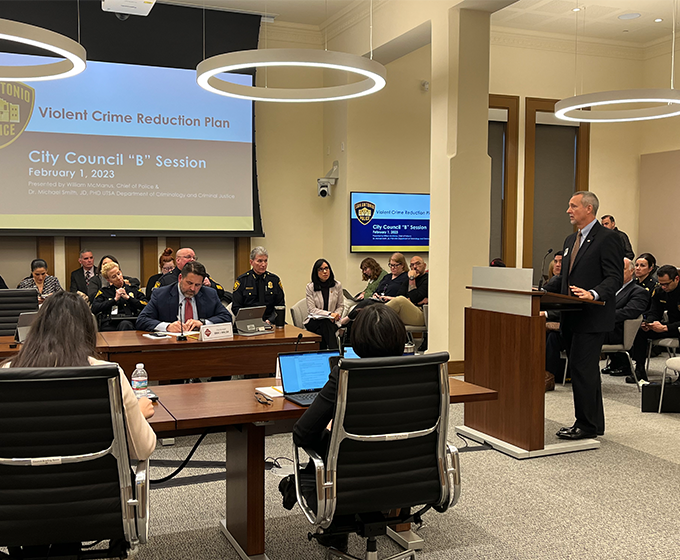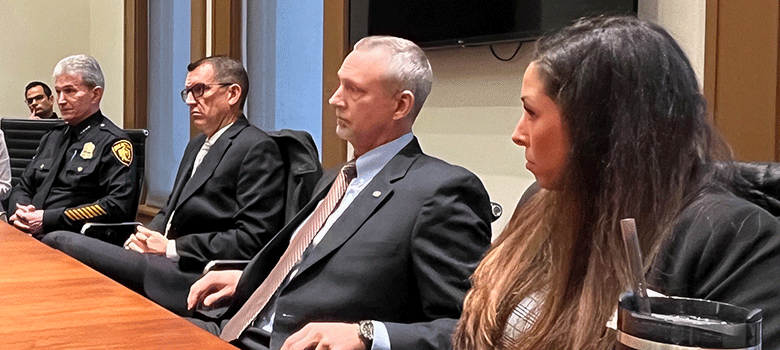
FEBRUARY 1, 2023 — UTSA criminologists are working with the City of San Antonio and the San Antonio Police Department (SAPD) to reduce violent crime through an evidence-based plan that has gained national attention.
Michael R. Smith, professor of criminology and criminal justice and director of the UTSA Center for Applied Community and Policy Research; Rob Tillyer, professor of criminology and criminal justice and associate dean for Graduate Student Success; and Chantal Fahmy, assistant professor of criminology and criminal justice, presented the violent crime reduction plan to the San Antonio City Council on Wednesday afternoon.
UTSA criminologists developed the data-driven plan to reduce violent street crime in San Antonio, which has increased 47% in the past three years. Aggravated assaults and gun-related deadly conduct are primarily driving the upward trend in violent crime.
Drawing on a large body of research, the plan involves implementing near-term, mid-term and long-term practices to drive down violent crime and eventually break the cycle of violence in the community. The plan is centered on research that violent crime is geographically concentrated in a relatively small number of places and the data showing that about 5% of offenders commit the majority of the city’s violent crimes.
“The Center for Applied Community and Policy Research and its Violent Crime Reduction Team are excited to partner with the San Antonio Police Department and the City of San Antonio as they implement this evidence-based violent crime reduction plan,” Smith said. “The strategies included in the plan are backed by more than 25 years of research, and we will be working closely with the SAPD and other city stakeholders to evaluate its impacts over the next several years.”
UTSA researchers have implemented similar plans in Dallas, Salt Lake City and Tacoma, Wash. Dallas was the first city to adopt the plan in May 2021 and has since seen an 11% reduction in violent crime in targeted hotspots and a similar decline in crime citywide.
The criminologists presented their plan for Dallas at the October meeting of the International Association of Chiefs of Police, the world’s largest police organization, and have been asked to speak at other conferences, Smith said. He often gets calls and emails from police departments across the country that are considering adopting a similar plan tailored to their cities.
SAPD began implementing the near-term stages of UTSA’s plan January 1, focusing police resources on certain hot spots — street segments or grids where crime is densely concentrated. The criminologists have found that increasing police visibility in these areas deters violent offenders from committing crimes.
Police officers will move to a new set of grids or hot spots in March, when the Violent Crime Reduction Team will analyze the data from the first set of hot spots. Smith said it takes about three weeks for the team to analyze the data, but the analysis will be preliminary because it’s the first period of a three-year plan. The criminologists will measure the impact of the plan every 60 to 90 days, adjusting as needed and report their findings to SAPD.
The mid-term strategy of the plan involves using Problem-Oriented, Place-Based Policing (POPBP) strategies that are carefully crafted to address the underlying conditions that contribute to recurring problems in areas where crime often occurs. In San Antonio, many of those locations are multifamily housing complexes.
This work would begin six to 12 months after the implementation of the hot spots policing. These place-based strategies often involve law enforcement, but they also require the help of other stakeholders who can help address the conditions that make certain locations attractive for crime. These strategies can be more effective at reducing crime than just increasing traditional police activities.
The Violent Crime Reduction Team will provide training to SAPD and other stakeholders on POPBP principles and help identify areas that need intervention, while also evaluating the impact of the strategies. Implementing the strategies will require the input and approval of a POPBP Advisory Board comprised of stakeholder department heads and a team of interdisciplinary department managers who will gather information about places prone to violence, identify problems and develop solutions for those problems.
The long-term strategy of the plan — focused deterrence — wouldn’t start until six to 12 months after POPBP begins. First designed and implemented in Boston in the 1990s, focused deterrence strategies have proved to be successful in reducing violent crime in more than 20 cities where they have been applied and evaluated. These strategies focus on changing the behavior of high-risk offenders through deterrence, arrests, community involvement and providing alternatives to violence.

From left to right: San Antonio Chief of Police William McManus joins UTSA professors Rob Tillyer, Michael R. Smith and Chantal Fahmy to present the violent crime reduction plan to the San Antonio City Council on Wednesday afternoon.
For repeat and high-risk offenders, interventions should offer an alternative to a violent lifestyle through a robust set of social, educational and job-related services to ensure these individuals change their lifestyles and stop committing violent crime. But for those who continue to commit violent crime, enhanced prosecution should be considered.
Individuals on probation or parole will be called in for quarterly meetings with criminal justice officials and others who convey messages of deterrence that violent crime harms the whole community. They also will connect the offenders to services, such as counseling, job training, housing assistance and substance use treatment. Those not on probation or parole will be contacted at home or on the street.
The UTSA criminologists will train SAPD and other stakeholders on the theories, evidence and requirements for instituting focused deterrence. They also will help identify the offenders who will be eligible for intervention.
The Violent Crime Reduction Team will conduct an independent evaluation of the focused deterrence strategies, examining factors like the services that were provided and whether the offenders changed their behavior.
For the plan to work and reduce violent street crime, city leaders must engage and support the work and get community stakeholders involved to help provide services to the individuals who are driving up crime. Violent crime is a community problem that cannot be resolved by SAPD alone and requires the city and the community to tackle deep-rooted social problems like homelessness, unemployment and domestic violence.
“This plan is a roadmap to a safer community. I want to thank the UTSA team for undertaking this groundbreaking effort for San Antonio,” said San Antonio Deputy City Manager Maria Villagomez. “We look forward to taking this plan out to our community to listen to their feedback and make adjustments as we analyze the data throughout this process.”
UTSA Today is produced by University Communications and Marketing, the official news source of The University of Texas at San Antonio. Send your feedback to news@utsa.edu. Keep up-to-date on UTSA news by visiting UTSA Today. Connect with UTSA online at Facebook, Twitter, Youtube and Instagram.
Move-in Day is an exciting time for incoming students. Students living in Laurel Village move in on August 22. The UTSA Housing and Residence Life (HRL) team looks forward to welcoming you all and helping you settle into your room.
Laurel VillageThe College of Sciences welcomes our newest Roadrunners to UTSA at VIVA Science! This interactive event connects students with faculty, staff, student leaders, and peers while highlighting the opportunities available across the College.
Outdoor Learning Environment 2 (OLE), Flawn Building, Main CampusWe're excited to welcome the new class of UTSA College of Liberal and Fine Arts (COLFA) students to campus! Move In To COLFA is strongly recommended for new students in COLFA because it gives you the chance to learn about the Student Success Center, learn how to do college successfully and meet new friends.
Galleria (MH 2.01), McKinney Humanities Building, Main CampusBuild connections with your Alvarez College of Business peers and learn more about the Career Compass program! This opportunity will provide fun interactions, giveaways and a chance to meet your next friend!
Richard Liu Auditorium (BB 2.01.02,) Business Building, Main CampusCelebrate the end of summer and the start off a great fall semester with The Housing Block Party! This event will have live music, carnival-style treats, artists, games, and activities galore. Come and join us for a night of fun!
Multipurpose Room/Lawn, Guadalupe Hall, Main CampusBe part of an unforgettable night as SOSA takes the field for its first public performance of the season! Experience the power, pride, and pageantry of UTSA’s marching band. Learn beloved traditions, practice cheers, and feel what it means to be a Roadrunner.
Campus Rec FieldsAfter getting your student settled in their room, connect with other UTSA families at our Family Get Together. Attendees need to RSVP for the event.
Rock & Brews Restaurant - 5702 Landmark Pkwy, San Antonio, TX 78249The University of Texas at San Antonio is dedicated to the advancement of knowledge through research and discovery, teaching and learning, community engagement and public service. As an institution of access and excellence, UTSA embraces multicultural traditions and serves as a center for intellectual and creative resources as well as a catalyst for socioeconomic development and the commercialization of intellectual property - for Texas, the nation and the world.
To be a premier public research university, providing access to educational excellence and preparing citizen leaders for the global environment.
We encourage an environment of dialogue and discovery, where integrity, excellence, respect, collaboration and innovation are fostered.